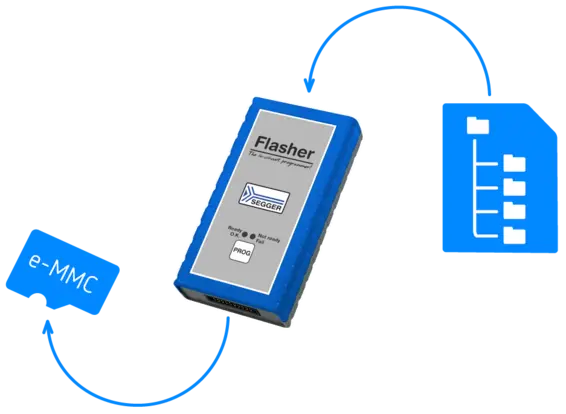FAT Image Creator
The FAT Image Creator stores a complete FAT file system including files and directory structure into a single binary image to be stored on an SD card, eMMC device or a USB drive.

Overview
The FAT Image Creator is a command line utility that simplifies rapid production programming of embedded or removable media, such as eMMC and SD cards with a FAT file image.
Because the FAT Image Creator is a command line tool, it effortlessly integrates into a CI/CD process, and removes all human interaction, enabling automatic creation of up-to-date production images.
The utility encapsulates an entire FAT file system in a single production file, including directory structure and files ready to be stored and used without preparation apart from mounting the file system. For this purpose, the utility creates a file on the host computer containing a virtual storage device where files and directories can be stored in the exact same way they are needed on the target device. It is possible to copy files and entire directory trees from the host computer to the created image. The image file created by the FAT Image Creator is an entire plain-binary file or an image in Motorola S-record format that contains only the necessary sectors required for production programming, which reduces both image transfer time and programming time. It can then be programmed in production, using tools such as the SEGGER Flasher family, to prepare memories of the target device for their life as an end product.
The utility ships in executable form for the Windows, macOS and Linux operating systems.
Key features
- Portable application
- Supports internal and external storage types, such as eMMC, SD card, and USB drive
- Multi-platform: Includes executable for Linux, macOS, and Windows
Use cases
Production programming
When a device is ready to ship, one of the many tasks is to get the data and firmware into the final product. With today's user interfaces and other data-intensive requirements, the storage medium often uses a file system to better manage the different types of data. A common standard is the FAT file system. To create such a structure, the memory device must be formatted, and then the data must be added to the file system in the form of files. This process can easily involve several repetitive steps that take time and increase the chance of errors in production, thus reducing yield. To reduce the production steps to a single write operation, the file system is created on a developer's system and then converted to a binary that can be used in production with production programmers such as SEGGER's Flasher series.

Performance
The image file created via the FAT Image Creator utility can be programmed as-is to the target storage device using an in-circuit programmer such as the SEGGER Flasher. Depending on the capacity of the storage device, the time required to program such an image file can be considerable. Not all the data blocks stored in the image file contain valid data, therefore it is possible to considerably reduce the programming time by making sure that only the valid data blocks are programmed. In order to help with this, the FAT Image Creator utility has the ability to extract the valid data blocks from the image file to a separate file in an industry-standard format, such as Motorola S-record.
System requirements
| Operating system | Version |
|---|---|
| Windows | Microsoft Windows (x86/x64) |
| macOS | macOS (x86) |
| Linux | List of supported Linux distributions (x86/x64) |
Licensing
FAT Image Creator is available under various Embedded Software License models and delivered in source code packages. With a wide range of licensing options, FAT Image Creator can fulfill commercial requirements as well as technical requirements. All licenses are one-time payments. FAT Image Creator is royalty-free and not subscription-based.